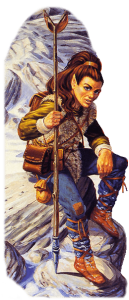Kender are the Jar Jar Binks of Dungeons of Dragons. They’re annoying and no one likes them, feeling that they are often nothing more than a horrible attempt of comedic relief.
In no way will I come to the defense of Jar Jar Binks, but I will say a few words about the Kender, because someone needs to stick up for the little guys.
Who are the Kender?
Created by Tracy Hickman and Margaret Weis, the kender are a race developed for the Dragonlance campaign setting. They were popularized in the Dragonlance series of novels, largely through the character Tasslehoff Burrfoot, one of the main protagonists in the series.
 Kender rarely grow over more than 4 feet tall. They obtain a wizened appearance as they grow older and have pointed ears which resemble those of elves. Kender speak very quickly when excited, which can make them difficult to understand, but they also have a wide vocal range, enabling them to perform impressive sound imitations. Finally, they have a distinctive topknot incorporated into their hairstyles.
Kender rarely grow over more than 4 feet tall. They obtain a wizened appearance as they grow older and have pointed ears which resemble those of elves. Kender speak very quickly when excited, which can make them difficult to understand, but they also have a wide vocal range, enabling them to perform impressive sound imitations. Finally, they have a distinctive topknot incorporated into their hairstyles.
But they also have thee character traits which is what largely bring many D&D players to loathe them.
First, kender have an intense curiosity which gives them a tendency to “borrow” objects. Kender have a habit of finding things that have dropped into their pouches by accident and are known to generally acquire things that belong to other people.
But kender do not think of this as stealing and are described as not believing that there is anything morally wrong with handling others’ items. In fact, Kender oppose actual thieving and are depicted as having little concept of monetary value. Instead, it’s a curiosity for the appearance trinkets and baubles and not an effort by kender to own them.
Second, kender are described as masters at the art of insulting people, using a wide repertoire of taunts and insults. This is made possible due to the kender’s intense curiosity leading to insights into other individual’s character flaws.
Finally, kender are portrayed as fearless, their curiosity pushing them beyond any pause to consider their individual safety.
As a side effect of these characteristics, kender can be difficult to role-playing game, with many D&D players having stories of kender being immaturely played as a silly kleptomaniacal child. A halfling version of Jar Jar Binks, in other words.
But that’s not giving the kender a fair shake. They should be playable in D&D 5e, so let’s make that happen.
Kender Playable as a 5e Race
Kender
D&D 5e Playable Race
Ability Score Increase. Your Charisma score increases by 1.
Alignment. Kender curiosity leans them toward chaotic alignments, though their kindness guides them toward good alignments.
Age. A kender’s natural lifespan is about 100 years. They remain childlike even when their bodies slow down. Kender view death as the next great adventure, and do not linger long in sadness after the passing of a loved one.
Speed. Your base walking speed is 30 feet.
Names. Fing Killacat, Crysta Goblinchaser, Tandit Summercloud, Talon Moonwillow, Yew Toestubb, Hakan Walkalong, Twig Shellcracker, Ragweed Rimrunner.
Curiosity. The curiosity of the kender knows no bounds. As a result, kender often “acquire” objects that are not theirs. Kender gain proficiency with Sleight of Hand checks and begin the game with five trinkets. In addition, once per day, you may search through your belongings to find any single item worth 2 GP or less and weighing 2 lbs or less, which you reasonably could have picked up in your travels.
Taunt. Kender are naturally skilled at exploiting the psychological weaknesses of their enemies. As an Action, you can force a target who can hear you and understand your language to make a Charisma saving throw against a DC equal to 8 + your proficiency bonus + your Charisma modifier. On a failed save, the target gains disadvantage on the next attack roll or ability check they make before the end of their next turn. A creature who fails their save gains advantage on subsequent saves against this ability.
Brave. A kender’s childlike innocence prevents them from fully grasping the consequences of their actions. As a result, Kender are immune to the frightened condition. They can however fear for the safety of their friends.
Innocence. A kender’s natural innocence make them terrible liars, so they make Deception checks at a disadvantage. Similarly, their size invokes more laughter than fear, so they make Intimidation checks at disadvantage.
Equipment. The hoopak (aka: halfling sling staff), a simple, but versatile martial weapon is the favored weapon of the kender and can be used as a staff, spear or sling. Damage is 1d4 bludgeoning or piercing (melee) or 1d4 bludgeoning (range).
The kender are drawn to the rogue and bard classes.

